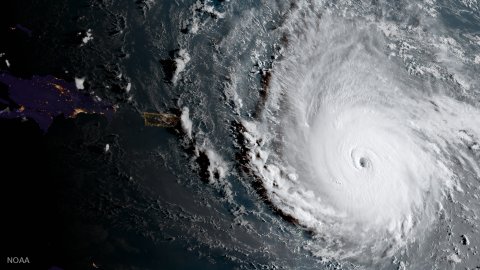By: Jordan Jenkins
Although the threat posed by the Atlantic hurricane season has always been present for those living along or within the Atlantic Ocean, it hasn’t always felt urgent or significant for many of those same people. The current century has, without a doubt, seen its share of major storms – such as Hurricane Katrina in 2005 and Superstorm Sandy in 2012 – but the reality is that most Atlantic hurricane seasons come and go without much incidence, allowing it to feel inconsequential for many of those most threatened by it.
Every so often, however, a season rife with strong and damaging storms comes along, reminding the public of the true force that these periods can provide. This current hurricane season has no doubt been one of those very examples, with a streak of major hurricanes, some of which are historic in nature.
The first of these was the Hurricane Harvey, which formed in late August and was the first major hurricane to make direct landfall on the mainland United States in nearly twelve years. Peaking at a Category 4, the storm followed a path that took it through the southern Caribbean, into eastern Mexico, and finally southeast Texas.
This is where a majority of the storm’s impact was felt, with the city of Houston and surrounding areas experiencing unprecedented amounts of rainfall and strong winds at the coasts. Flooding ensued, with mass amounts of residents needing to be rescued from their now flooded homes.This was compounded by the storm’s lingering path, which resulted in it hitting areas multiple times before finally moving along.
In the aftermath, more than 30,000 people in Houston proper and its surrounding areas had been displaced, with even more experiencing property damage from the floods and winds. As more of this recovery gets underway and the full extent of the damage is seen, Harvey may very well end up being the most expensive hurricane in United States history.
With all this happening, increased pressure was being put on the public services in affected areas, such as the local schools. Mrs. Ashlynn Ramirez, an Assistant Principal here at Apopka High School, saw this and was compelled to act, organizing a donation drive in support of the local schools.
When originally interviewed, she said, “Anytime a disaster hits like that…the biggest need is consistent support,” later going on to say: “A lot of times — kind of like what we’re doing — people just make one-time donations and then kind of walk away from it…onto something else.”
Her prediction rang true, seeing as not soon after the passing of Harvey, Central Florida saw a major hurricane of its own. Forming on August 30 and becoming the second consecutive major hurricane of the season, Hurricane Irma even went so far as to outdo its predecessor, peaking at an astounding Category 5. It soon became the most powerful hurricane seen in the Atlantic in more than a decade.
It followed a path of destruction through the Caribbean, pummeling nearly all of its islands with high-speed winds and massive amounts of rainfall, before making a jarring swivel northward while it was above Cuba, taking a path that sliced right through the state of Florida. Much of the state, from the Keys to Jacksonville, experienced severe weather. Its path ran very close to Apopka, which experienced mass amounts of rain, strong winds, and related power outages.
For some, the impacts of the storm were inconsequential and short-lived, such as in the case of Apopka High School sophomore and staff writer at the Blue and White, Jamari Saint Cyr. On his experience with Hurricane Irma, he said, “My power went out for five minutes or so, then it came back. Nothing really bad happened.”
For others, however, the problems faced in the storm’s aftermath were extensive and continue to persist. Apopka High School Senior Stephanie Lloyd “We lost power right before the worst of the hurricane came on Sunday, and we were told by Duke Energy [the local energy provider] that we’d have our power back on Wednesday,” senior Stephanie Lloyd described. That wasn’t the case, however, as by the Sunday of the following week her household was still without power. “My grandfather literally had to go out to find a Duke truck, flag them down to get them to fix our power,” she later elaborated.
Physical damage was also rampant, with uprooted trees and damage to buildings being common throughout the city. In some low-lying areas in Central Florida, flooding also happened, causing week-long school closures throughout the state. Similar scenes played out all over the state and the country, giving Hurricane Irma the unofficial title fourth most expensive storm in United States history.
While many focus on the local recovery from the storm, hurricane season presses onward. Fast-forming and strong storms are continuing to wreak havoc, such as Hurricane Maria, another Category 5 that has decimated the U.S. Territory of Puerto Rico. The chance that Central Florida could see another major storm is – at the very least – considerable; especially when you consider the fact that hurricanes that have formed this season have had a knack for strengthening at a breakneck speed. Hurricane Maria, for example, escalated from a relatively insignificant tropical depression to a massive Category 5 hurricane in the span of two and a half days.
In the light of these trends, many have pointed to global warming as a contributing factor in the seemingly rising severity of storms, but any scientific conclusion or related action would take years to implement and have any effect. In the meantime, large populations have little to do but prepare themselves to the best of their ability for whatever comes next.


